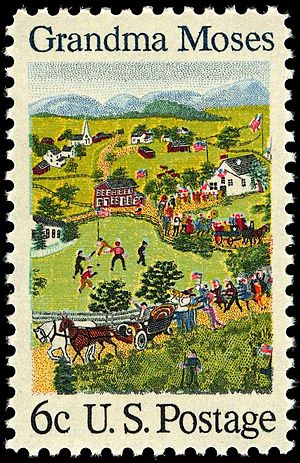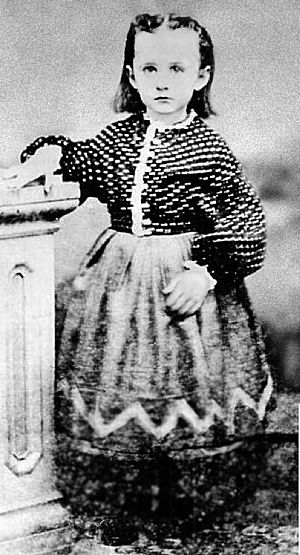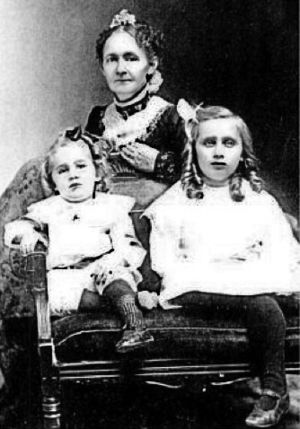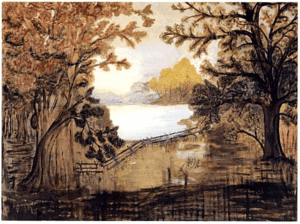Grandma Moses facts for kids
Quick facts for kids
Grandma Moses
|
|
|---|---|

Moses, c. 1950
|
|
| Born |
Anna Mary Robertson
September 7, 1860 Greenwich, New York, U.S.
|
| Died | December 13, 1961 (aged 101) Hoosick Falls, New York, U.S.
|
| Known for | Painting, embroidery |
|
Notable work
|
The Old Checkered Inn in Summer |
| Spouse(s) |
Thomas Salmon Moses
(m. 1887; |
Anna Mary Robertson Moses (born September 7, 1860 – died December 13, 1961), known as Grandma Moses, was a famous American folk artist. She started painting seriously when she was 78 years old. She is a great example of someone who found success in art later in life.
Her paintings have been shown and sold all over the world. They are even in museums! Her art has also been used on things like greeting cards. One of her paintings, Sugaring Off, sold for $1.2 million in 2006.
Grandma Moses appeared on magazine covers and television shows. She even had a movie made about her life. Her autobiography is called My Life's History. She won many awards and received two special university degrees.
The New York Times newspaper said that Grandma Moses's paintings showed simple farm life. They had a warm, old-fashioned feeling and bright colors. She was good at showing the excitement of the first snow or getting ready for Thanksgiving. In person, Grandma Moses was a small, lively woman with a quick sense of humor.
She worked as a housekeeper for 15 years, starting when she was just 12. One of her employers noticed she liked art prints. They gave her drawing supplies. Later, she and her husband lived and worked on farms in Virginia. In 1905, they moved back to Eagle Bridge, New York. They had ten children, but only five lived past infancy. Before painting, she made pictures with yarn. She stopped when arthritis made it too painful.
Contents
Early life and first art experiences
Anna Mary Robertson was born in Greenwich, New York. This was on September 7, 1860. She was the third of ten children. Her parents were Margaret Shanahan Robertson and Russell King Robertson. She grew up with four sisters and five brothers. Her father was a farmer and ran a flax mill.
She went to a one-room school for a short time. This school is now the Bennington Museum in Vermont. The museum has the largest collection of her art in the United States. Anna was inspired to paint by art lessons at school. As a child, she used lemon and grape juice to make colors. She also used ground ocher, grass, and flour paste for her "landscapes."
When she was 12, she left home. She worked doing farm chores for a rich family nearby. She continued to work as a housekeeper, cook, and seamstress for wealthy families for 15 years. One family, the Whitesides, saw she liked their Currier and Ives art prints. They bought her chalk and wax crayons.
Marriage and family life
When Anna was 27, she worked on the same farm as Thomas Salmon Moses. They got married and moved near Staunton, Virginia. They lived there for almost 20 years. They worked on five different farms during that time. To earn extra money, Anna made potato chips. She also made butter from her cow.
Later, the couple bought their own farm called Mount Airy. This was near Verona, Virginia. It was their first home that they owned. They lived there from 1901 to 1902.
Anna and Thomas had ten children. Sadly, only five of them lived past being babies. Anna loved living in the Shenandoah Valley. But in 1905, her husband wanted to move. So, they moved to a farm in Eagle Bridge, New York.
Thomas Moses died in 1927 from a heart attack. He was about 67 years old. After his death, Anna's son Forrest helped her run the farm. She never married again. In 1936, she stopped farming and moved in with her daughter. People called her "Mother Moses" or "Grandma Moses." The name "Grandma Moses" stuck after the newspapers started using it.
From embroidery to painting
As a young wife and mother, Anna was very creative at home. For example, in 1918, she painted a fireboard using house paint. Starting in 1932, Grandma Moses made embroidered pictures for her friends and family. She also made quilted items.
By the time she was 76, Moses had arthritis. This made embroidery painful for her hands. Her sister Celestia suggested that painting might be easier. This idea helped start Moses's painting career in her late 70s. Grandma Moses also said she started painting to make a Christmas gift for the postman. She said it "was easier to make [a painting] than to bake a cake over a hot stove." Paintings also lasted longer than her embroidered wool pictures, which could be eaten by moths. She felt proud that she could "make something from nothing." When her right hand hurt, she even switched to painting with her left hand.
Her art career begins
Grandma Moses's interest in painting later in life was actually a dream from her childhood. She had no time to paint during her busy farm life. So, she had to put her passion aside. When she was 92, she wrote, "I was quite small, my father would get me and my brothers white paper by the sheet. He liked to see us draw pictures, it was a penny a sheet and lasted longer than candy."
Painting style and themes
Moses painted scenes of rural life from earlier times. She called them "old-timey" New England landscapes. She said she would "get an inspiration and start painting." Then she would "forget everything" except how things used to be. She wanted people to know how life was lived in the past. She left out modern things like tractors and telephone poles from her art.
Her early paintings were simpler and more realistic. They sometimes lacked perfect perspective. At first, she made simple pictures or copied existing ones. As she painted more, her art became more detailed. She created wide, sweeping scenes of country life.
She painted a lot, making over 1,500 paintings in 30 years. At first, she sold her paintings for $3 to $5. As she became famous, her works sold for $8,000 to $10,000. Her winter paintings remind some people of the famous painter Pieter Bruegel the Elder. However, she had never seen his work. A fan from Germany said her paintings showed a "light-hearted optimism." They showed a beautiful and good world.
First art shows
In 1938, an art collector named Louis J. Caldor saw Moses's paintings. They were in a drug store window in Hoosick Falls. He bought all the paintings there. Then he bought ten more from her house for $3 or $5 each.
The next year, three of Grandma Moses's paintings were in a show. It was at New York's Museum of Modern Art. Her first solo art show was called "What a Farm Wife Painted." It opened in New York in October 1940. She also had a special event at a department store. There, she met people and showed 50 paintings. Her art displays even included samples of her baked goods and preserves! These had won prizes at the county fair.
Her paintings were shown all over Europe and the United States for the next 20 years. Her art was used to promote American holidays. These included Thanksgiving, Christmas, and Mother's Day. Her paintings were put on Hallmark greeting cards, tiles, and fabrics. They were also used to sell products like coffee and cameras.
Awards and recognition
In 1950, the National Press Club named her one of the five most important women in the news. Mademoiselle magazine called her a "Young Woman of the Year" when she was 88. She received two special university degrees.
President Harry S. Truman gave her an award for her art in 1949. A movie about her life was made in 1950. It was even nominated for an Academy Award. In 1952, she wrote her autobiography, My Life's History. She said in it, "I look back on my life like a good day's work, it was done and I feel satisfied with it." In 1955, she appeared on a TV show called See It Now.
Later life and passing
Grandma Moses was a member of the Society of Mayflower Descendants. She was also part of the Daughters of the American Revolution. New York Governor Nelson Rockefeller declared her 100th birthday "Grandma Moses Day." LIFE magazine featured her on its cover on September 19, 1960. A children's book about her, Grandma Moses Story Book, was published in 1961.
Grandma Moses passed away at age 101 on December 13, 1961. She died at the Health Center in Hoosick Falls, New York. She is buried there at the Maple Grove Cemetery. President John F. Kennedy honored her memory. He said her paintings brought a fresh look to American life. He also said her work and life helped the nation remember its pioneer history.
Her lasting legacy

One of her paintings, The Old Checkered House, 1862, was valued at an Antiques Roadshow in 2004. It was bought for less than $10 in the 1940s. The appraiser said it was worth $60,000 for insurance.
In November 2006, her painting Sugaring Off (1943) sold for $1.2 million. This was her highest-selling work.
Her painting Fourth of July (1951) was given to the White House in 1952. This painting also appears on a U.S. postage stamp. The stamp was made in Grandma Moses's honor in 1969.
The character Daisy "Granny" Moses on The Beverly Hillbillies TV show was named after Grandma Moses. This was a tribute to her.
Norman Rockwell and Grandma Moses were friends. They lived near each other across the Vermont-New York border. Grandma Moses lived in Eagle Bridge, New York. Norman Rockwell had a house in nearby Arlington, Vermont. She can be seen on the far left side of Rockwell's painting Christmas Homecoming. This painting was on The Saturday Evening Post magazine cover in 1948.
Collections of her work
Here are some places where you can see her paintings:
- Bennington Museum in Bennington, Vermont (has the largest collection)
- Brooklyn Museum, New York City
- Figge Art Museum, Davenport, Iowa
- Hirshhorn Museum and Sculpture Garden, Washington D.C.
- Lauren Rogers Museum of Art, Laurel, Mississippi
- Maier Museum of Art at Randolph-Macon Woman's College, Virginia
- Memorial Art Gallery of the University of Rochester, New York
- Metropolitan Museum of Art, New York City
- Muscarelle Museum of Art, William & Mary, Williamsburg, Virginia
- National Museum of Women in the Arts, Washington D.C.
- The Phillips Collection, Washington D.C.
- Smithsonian American Art Museum
- University of Iowa Museum of Art, Iowa City
Selected paintings
- Autumn in the Berkshires
- Black Horses, 1942
- Bondsville Fair, 1945
- Catching the Thanksgiving Turkey, San Diego Museum of Art
- Christmas, 1958
- Dividing of the Ways, 1947
- English Cottage Flower Garden, embroidery
- Get Out the Sleigh, 1960
- Grandma Moses Goes to the Big City, 1946
- Haying Time, 1945
- Home of the Hezekiah King, 1776, 1943
- Home for Thanksgiving, 1952
- Hoosick Falls, 1944
- Jack 'n Jill
- July Fourth, 1951
- My Hills of Home, Memorial Art Gallery of the University of Rochester, New York
- Out for Christmas Trees
- Rockabye, 1957 (Grandma Moses with her grandchildren)
- The Childhood Home of Anna Mary Robertson Moses, 1942
- Thanksgiving Turkey
- The Daughter's Homecoming
- The Old Checkered House
- The Old Covered Bridge
- The Old Oaken Bucket
- The Red Checkered House
- Turkey in the Straw, c. 1940
- White Christmas
- Winter is Here, 1945
See also
 In Spanish: Anna Mary Robertson Moses para niños
In Spanish: Anna Mary Robertson Moses para niños




